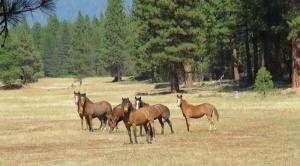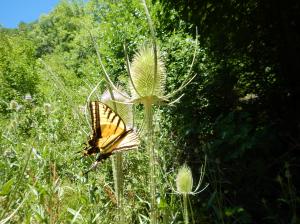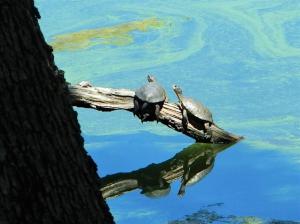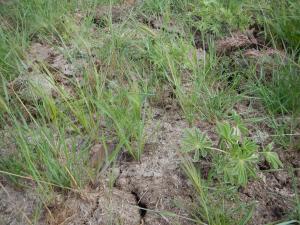American Wild Horses Are Understudied: That Results In Grossly Overlooked Ecological Benefits

A family of wild horses that lives in a remote forest have symbiotically grazed-in a fire-break, which is protecting a forest of champion old-growth conifers against catastrophic wildfire. Excess fuel loading causing abnormally hot wildfire kills everything
Entire forest ecosystems can be made wildfire resilient via the nature-based re-deployment of wild horses as envisioned by the nonprofit Wild Horse Fire Brigade
YREKA, CA, US, March 6, 2023 /EINPresswire.com/ -- North American wild horses evolved on the North American continent about 1.8-million years ago.Recent scientific research shows that the populations of North American wild horses did decline significantly around the time of the last Ice Age, however, they did not go extinct. In fact, we now know that many splinter populations of American wild horses survived the Ice Age and continued to exist on the continent prior to the initial arrival of Columbus in 1492.
Moreover, we now have ample paleontological and cultural archeology that provides strong evidence of wild horses living among indigenous American peoples well before the Pueblo Revolt of 1680, which has been argued as the event that released Spanish horses onto the landscape, resulting in the spread of re-introduced horses into America.
Over 100-years before the Pueblo Revolt, and just 90-years after Columbus first arrived, Sir Francis Drake explored the western coastline of the United States. And in the area of what is today, the California-Oregon border, Drake observed and documented indigenous peoples living-among herds of wild horses, in the year 1580.
This PBS video arguably ends the debate about the Native Species status of American Wild Horses. https://www.youtube.com/watch?v=HGki2EwrbkA
As you watch the evidence presented, keep in mind that the California-based all-volunteer 501-c-3 nonprofit public benefit corporation ‘Wild Horse Fire Brigade’. is researching a herd of horses that was documented by the British explorer Sir Francis Drake in the year 1580, 100 years before the 'Pueblo Revolt'.
In this PBS production, several scientists weigh-in against the misinformation that has largely been spread by the Bureau of Land Management over decades, falsely claiming that wild horses are 'not native'. The BLM is also documented as falsely claiming that wild horses have 'no natural predators' which is another proven myth.
How can anyone logically or cost-effectively manage any wildlife, let alone a treasured species like our American Wild Horses, based upon myths?
Watch this PBS video and learn the truth from a team of scientists.
On YouTube: https://www.youtube.com/watch?v=HGki2EwrbkA
Over the millennia, and through the evolutionary forces of Nature, wild horses developed many co-evolved mutualisms and symbiotic relationships with North American flora and fauna.
From an informed ecological perspective, wild horses became the most important large-bodied herbivory on the continent, and that fact is well demonstrated by the many symbiotic relationships and mutualisms they share within the ecosystems that make up their natural habitats.
Before we can move into the discussion of the ecological importance of wild horses, there are two important terms that must be understood.
Those terms are ‘symbiosis’ and ‘mutualism’ (excerpts from: *Biologyonline.com).
*Symbiosis can be defined as any kind of relationship or interaction between two dissimilar organisms, each of which may receive benefits from their partners that they did not have while living alone (Angelard & Bever, 2013). Ecologists define “symbiosis” as a close, long-term association between organisms of different species. Other common ecological symbiotic interactions between or among species are commensalism, parasitism, predation, cooperation, mutualism, and competition.
*Mutualism is a form of symbiosis that is characterized by both species benefiting from the association. It is one of the symbiotic relationships occurring in nature.
Examples of Mutualism and Symbiosis in Wild Horses
Wild horses are subject to parasites such as ticks. The tick is the symbiont that benefits in this example by consuming tiny amounts of blood from the host, who in this case is the horse. This is a symbiosis that is not beneficial to the horse, just the tick, which is the parasite in this example of symbiosis.
However, that parasitic symbiosis is of benefit to another animal that shares a beneficial mutualism with the horse, birds.
Birds, such as magpies and scrub jays, will perch on wild horses and remove parasites such as ticks from areas that are difficult or hard to reach for horses. The bird benefits by way of a secure perch on top of an alert prey-animal (the horse) and also has a food supply. The removal of the parasites benefits the horse, so this is an example of mutualism that is characterized by both species benefiting from the association.
Wild Horses and Trees – A Unique Mutualism
It is arguable that unlike any other large-bodied herbivore on the north American continent, wild horses share an evolutionarily evolved beneficial mutualism with trees.
Wild horses use trees for shelter year-round. In heat of the summer, they seek shelter in the shade of the tree, and in the winter, trees offer protection from snow and rain. Clearly, wild horses benefit from trees as shelter.
How Do Forests and Trees Benefit from Wild Horses?
Wild horses will graze and manage the grass and brush under the trees they use for shelter. This reduces the heat and flame-height of any wildfire that happens to pass under the tree. Wild horses will also fertilize the trees they use for shelter with their nutrient-rich dung, which benefits trees.
Horses are large animals that can weigh up to 1,200 pounds in the wild. They are tall bodied, with heads that can reach 6-7 feet above ground, and backs that are generally 5-feet above the ground. So, when horses scratch their backs and heads, they will easily break-off any dead limbs from the tree that are below 6 to 7-feet above ground. These low-hanging limbs are known to foresters and fire-fighters as ‘fire-ladders’. And that’s because these dead-limbs provide fuel and a path for wildfire to climb into the canopy of a tree. The removal of these limbs by wild horses makes any tree more fire resilient.
Wild horses that live in and around forests and using trees as shelter can make entire forests of trees healthier and more wildfire resilient.
Invasive Species Ruminant Herbivores – Parasitic Symbiosis
Both science and recorded history prove that cattle, sheep and most goats evolved off the American continent. These exotic species herbivores were first introduced into America in the 16th century by Spanish settlers to North America. These imported livestock species, cattle, sheep and most goats are indeed an invasive species since they did not evolve on the North American continent and did not have the required millennia in time to develop any evolved mutualisms with North American flora and fauna.
Ruminant grazers, like cattle, sheep, goats (and all cervids; including deer & elk) have multi-chambered stomachs, chew a cud, and are extremely effective digesters of the plant and grass seeds they consume. Therefore, these ruminant herbivores digest most of the seeds they consume, which ends the life-cycles of the plants and grasses that they consume. Over time, this ruminant grazing process has many adverse impacts, including:
1. Reduction of native cover crops, which results in loss of infiltration of annual precipitation; and,
2. Loss of soil stability resulting in abnormal erosion impacting water quality and fisheries; and
3. Declines in plants and grasses that are sustenance for co-evolved fauna that depend upon native plants for their survival, including other large and small mammals, birds, insects and pollinators.
4. Reduction of native plants/grasses carbon-cycling and carbon sequestration that reduces greenhouse gases.
In fact, most species of deer and also bison are relative newcomers onto the North American continent compared to wild horses. Most cervids and bison are estimated to have arrived in North American via the Bering Land Bridge within the last 200-thousand years.
Wild Horses and Native Flora – Another unique mutualism in North America
Of all the large-bodied herbivores in North America, wild horses are unique; they are not ruminants. Horses have just one stomach and unlike any other herbivore in North America, they pass most of the plant and grass seeds they eat back out onto the soil of the landscape intact and able to germinate in their dung.
Essentially, wild horses are reseeding the landscapes where they graze and completing the essential life-cycles of the native flora that nourishes them. And that beneficial reseeding also benefits a myriad of other fauna including other small and large mammals, birds and even insects and pollinators.
This is a perfect example of beneficial mutualism.
This short 2-minute video highlights just a couple important mutualisms wild horses have in wilderness ecosystems:
‘Frogs, Bees and Horses’: https://www.youtube.com/watch?v=LHZ23X316lM
This is a critically important evolutionary fact that relates to the importance of the digestive system of the horse to the wilderness ecosystems where they live.
And it is why, scientifically speaking, wild horses are keystone herbivores on the American landscape and must be managed with great care and using the latest, best available science.
The wilderness research team (M. Gough - W. Simpson) at Wild Horse Fire Brigade's research station on the edge of the Soda Mountain Wilderness area (OR-CA border) is making revolutionary new discoveries about wild horses via their study of a herd of horses that cultural archaeology suggests are the descendants of post Ice Age wild horses that were documented by Sir Francis Drake in 1580 [*], living on what is today's OR-CA border west of Klamath Falls, and originally ranging to the Pacific coast. There are relatively few of these important heritage horses left.
Wild Horse Fire Brigade intends to make sure they are protected from mismanagement through a cooperative program of education and natural rewilding of wild horses into critical wilderness areas that are both ecologically and economically appropriate.
"We are living-among and studying (using the 'Goodall Method') a herd of wild horses whose ancestors were observed and documented by *Sir Francis Drake in 1580! This makes the herd of wild horses we are studying the descendants of wild horses that were a splinter population that survived the Ice Age! That is important from a genetic perspective", said M. Gough, researcher and board member at Wild Horse Fire Brigade.
*Data from doctoral dissertation of Yvette 'Running Horse' Collin, PhD: https://scholarworks.alaska.edu/handle/11122/7592
Check out this 2-minute video about 'Buffy' one of the horses in our privately-owned herd that shows some interesting genetic traits
Buffy's Ancestry - Genetics that extend back to the Ice Age? YouTube: https://www.youtube.com/watch?v=kNfGdvjmAE0
It is the hope of the team at Wild Horse Fire Brigade that wild horse advocates, nonprofits, and land managers can move past myth, and begin anew and work to educate others as to our Nature-Based Solution to better manage wildfire fuels and the relatively few remaining genetically-intact American wild horses in a practical and genetically sustainable manner for long-term conservation.
The widespread use of ‘Genetic Poisons’ (so-called 'fertility control' commonly called 'PZP' & Gonacon) is of great concern to the research team (Simpson - Gough), given the vast majority of wild horses captured by the Government agencies are now non-breeding castrated stallions and sterilized mares (~65,000 wild horses).
What older genetic-lines have already been lost due to this ongoing mismanagement?
Added to which, the remaining wild horse populations free on the landscape are being aggressively treated with sterilants such as PZP and the new versions of Gonacon.
That should be a huge concern to anyone who actually understands genetics and the long-term impacts of what amounts to being a very short-sighted economically driven perspective.
About Wild Horse Fire Brigade's wild horse wilderness research:
It is believed that the researchers M. Gough and W.E. Simpson II are the only researchers in America today who live-among and study free-roaming wild horses in a remote mountainous wilderness area. Simpson is going-on his 9th year of continuous study and has documented how wild horses can help firefighters stop wildfires, and how horses helped CALFIRE during an actual wildfire, and how wild horses make forests more fire resilient, while enhancing the ecosystem much to the benefit of all the other co-evolved flora and fauna.
Some of W. Simpson’s peers and elected officials have commented about his experience and research in writing, which can be read at this PDF:
https://www.wildhorsefirebrigade.org/_files/ugd/b50928_d4424087009e4d319c0915981ebcbf25.pdf
William E. Simpson II
Wild Horse Fire Brigade
+1 858-212-5762
email us here
Visit us on social media:
Facebook
Twitter
Instagram
YouTube
Other
Frogs and Pollinators are seen a signs of healthy ecosystems where wild horses are keystone herbivores
Legal Disclaimer:
EIN Presswire provides this news content "as is" without warranty of any kind. We do not accept any responsibility or liability for the accuracy, content, images, videos, licenses, completeness, legality, or reliability of the information contained in this article. If you have any complaints or copyright issues related to this article, kindly contact the author above.




